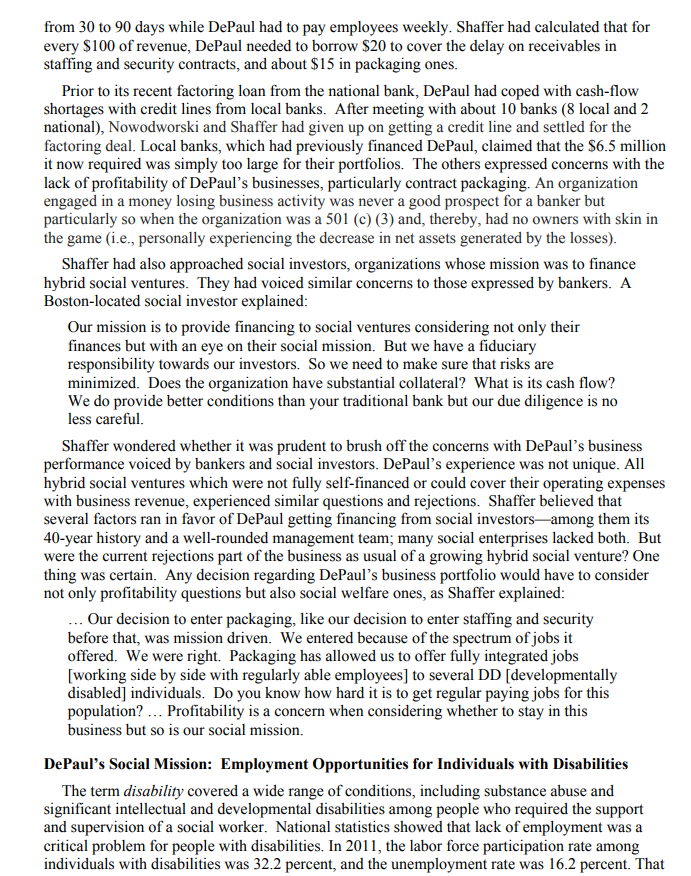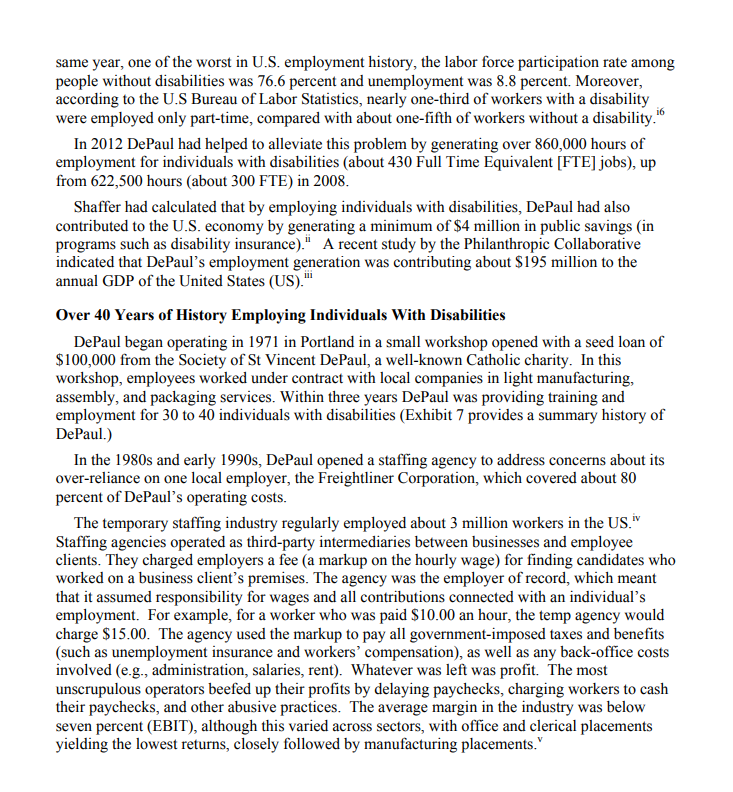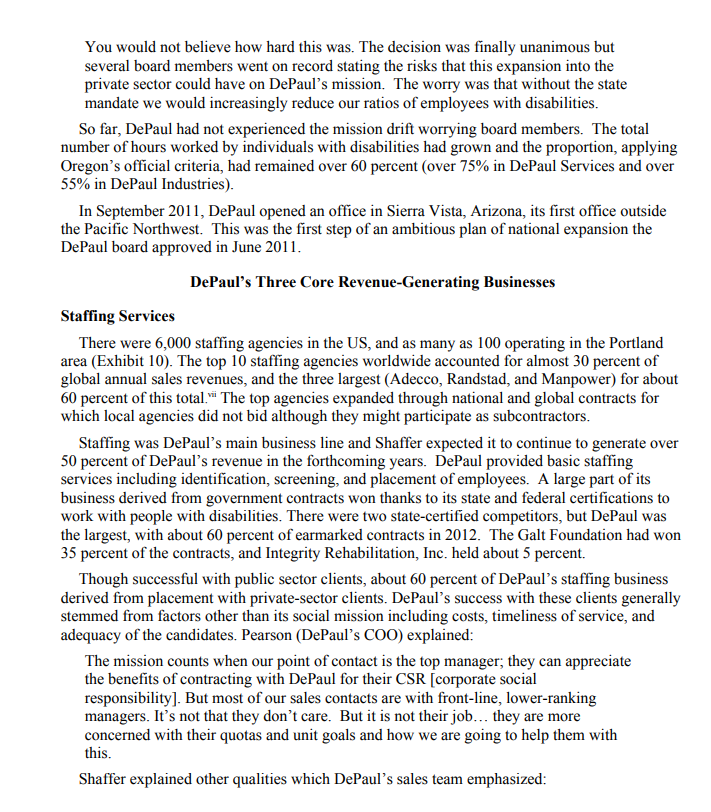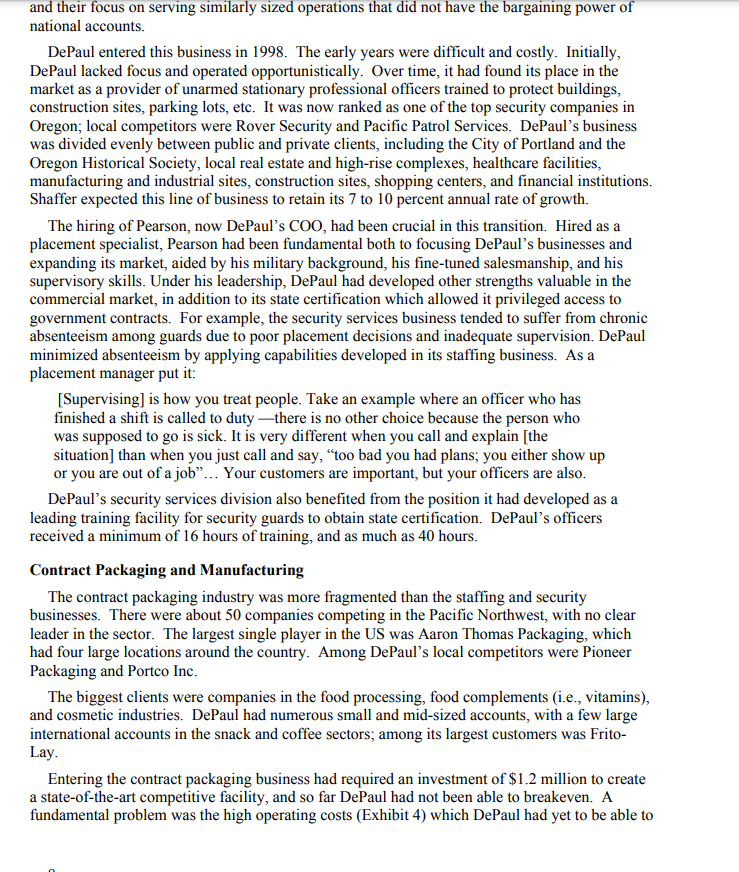Assess the long-term profit potential of the three industries in whichDePaulcompetes (staffing, security, contract packaging) by applying Porter's five-force model.
Portland, Oregon. DePaul Industries CFO Jim Nowodworski walked into President & CEO Dave Shaffer's office on Friday June 22, 2012. With him was the loan officer from a large national bank. Nowodworski and Shaffer had been negotiating a $7.5 million financing package with her. She informed them that the bank had approved their request for a $6.5 million factoring loan, but denied the $1 million mortgage meant to pay in full a similar one that was due in just one week's time. Shaffer's memory of the recent visit was vivid: I became speechless ... almost! We had been courting the bank for about two years and had spent the last six months negotiating the underwriting of the factoring loan. All this time the mortgage loan had been a given and now they were saying NO? All I managed to say was, "Do you know what bind this creates for us? Do you know this is the 11" hour-no, actually it's the 11:30 hour!" By the following Friday, Nowodworski and Shaffer had managed to talk the bank into giving DePaul a $1 million 90-day bridge loan. They had saved the day (once more) but for Shaffer "this was the last straw." He already had some ideas about where to get another mortgage loan, but was DePaul on the right path? He saw this episode as one more in a long litany of negotiations with banks that misunderstood and distrusted DePaul's hybrid social venture nature, namely its integrating of social welfare and economic goals. But could it be a wake-up call, a signal that the strategic plan that DePaul's board had approved a year earlier needed rethinking? Financing challenges: Business as usual or wake-up call? Shaffer had been negotiating financing deals since he became DePaul's CFO in 2001, supporting its growth to almost $30 million in revenue. By 2012, he was used to puzzled looks and general distrust for DePaul's business approach to serving its social mission. DePaul in fact comprised two organizations, DePaul Industries serving private clients and DePaul Services serving government clients, both registered as 501 (c) (3) tax-exempt organizations. They both had the same mission, namely to identify and generate employment opportunities for people withdisabilities (Exhibit 1). In 2012, DePaul had employed 1,700 people over the course of the year and, over the previous two years, an estimated 700 individuals had found permanent work after starting as DePaul temporary placements. Shaffer described DePaul's hybrid social venture nature: There are companies that are nonprofit. There are companies that are total for- profit. We operate in the space in the middle, a very unique blend of the two. We expect our businesses both to be economically viable and achieve significant mission goals. It's not one or the other.* DePaul could have chosen to finance all its operations through donations but Travis Pearson (DePaul's Chief Operating Officer) explained its alternative approach: This is at odds with who we are. We are helping people with disabilities by giving them jobs; by asking them to help themselves; to make their own money and pay their own bills. It is only fair that we do the same thing; that we pay for our bills with revenue from our businesses. This approach was also a difficult sell. Donors questioned the need to help an organization that appeared able to finance itself. Moreover, donations were woefully insufficient to finance DePaul's rate of growth and were not free. In 2012, DePaul was projected to raise $678,000 in donations, netting just under $500,000 after deducting the direct costs associated with fundraising (Exhibit 2). The most important source of financing for DePaul operations was the revenue generated by its three core business ventures: staffing services, security services and contract packaging services. In 2012, staffing services and security services were projected to generate $17 million and $6 million in revenue respectively; and earn 6% and 7% operating margin respectively. The contract packaging and manufacturing business had generated about $6 million in revenue and had never turned a profit. (See Exhibits 3-6 for financials.) In addition to these three businesses, DePaul also ran training and support employment programs for individuals with significant intellectual and developmental disabilities. These generated some revenue ($138,000 and $519,000 respectively in 2012) but were supported through grants and the revenue from the other businesses. Support employment programs were group-based, in which disabled individuals engaged in simple manual tasks under the supervision of a social worker in DePaul's own plant, alongside other workers. DePaul also ran a Project Search model, involving direct supervision but with employees working in clients' locations and paid competitive wages, unusual for individuals with developmental disabilities. Staffing, security, and contract packaging were employment-intensive businesses, which suited DePaul's mission well. They were also cash-flow intensive, with billing cycles rangingfrom 3D to fill days while DePanl had to pay employees weekly- Shaffer had calculated that for every Stoo of revenue, DePaul needed to borrow {ill} to cover the delay on receivables in staffing and security contracts, and about $15 in packaging ones. Prior to its recent factoring loan from the national bank, DePaul had coped with cash-ow shortages with credit lines from local banks. After meeting with about It} banks [8 local and 2 national), blowodworski and Shaffer had given up on getting a credit line and settled for the factoring deal. Local banks, which had previously nanced DePaul, claimed that the $6.5 million it now required was simply too large for their portfolios. The others expressed concerns with the lack of protability of DePaul's businesses, particularly contract packaging. An organization engaged in a money losing business activity was never a good prospect for a banker but particularly so when the organization was a Sill {c} (3} and, thereby, had no owners with skin in the game (i.e., personally experiencing the decrease in net assets generated by the losses}. Shaffer had also approached social investors, organizations whose mission was to finance hybrid social ventures. They had voiced similar concerns to those expressed by bankers. A Boston-located social investor explained: Dur mission is to provide fmancing to social ventures considering not only their finances but with an eye on their social mission. But we have a duciary responsibility towards our investors. So we need to make sure that risks are minimized. Does the organization have substantial collateral? What is its cash flow? We do provide better conditions than your traditional bank but our due diligence is no less careful. Shaffer wondered whether it was prudent to brush off the concerns with DePanl's business performance voiced by bankers and social investors. DePaul's experience was not unique. All hybrid social ventures which were not fully self-nanced or could cover their operating expenses with business revenue, experienced similar questions and rejections. Shaffer believed that several factors ran in favor of DePaul getting financing from social investorsamong them its 4tl-year history and a well-rounded management team; many social enterprises lacked botlt. But were the current rejections part of the business as usual of a growing hybrid social venture? Doe thing was certain. Any decision regarding DePaul's business portfolio would have to consider not only profitability questions but also social welfare ones, as Shaffer explained: - .. {lur decision to enter packaging, like our decision to enter stafng and security before that, was mission driven. We entered because of the spectrum of jobs it offered. We were right Packaging has allowed us to offer rlly integratedjobs [working side by side with regularly able employees] to several DD [developmentally disabled] individuals- Do you know how hard it is to get regular paying jobs for this population? Profitability is a concern when considering whether to stay in this business but so is our social mission. DePanl's Social Mission: Employment Opportunities for Individuals with Disabilities The term disability covered a wide range of conditions, including substance abuse and significant intellectual and developmental disabilities among people who required the support and suWision of a social worker. National statistics showed that lack of employment was a critical problem for people with disabilities- In 2&1 l, the labor force participation rate among individuals with disabilities was 32.1 percent, and the unemployment rate was 16.2 percent. That same year, one of the worst in U.S. employment history, the labor force participation rate among people without disabilities was 76.6 percent and unemployment was 8.8 percent. Moreover according to the U.S Bureau of Labor Statistics, nearly one-third of workers with a disability were employed only part-time, compared with about one-fifth of workers without a disability." In 2012 DePaul had helped to alleviate this problem by generating over 860,000 hours of employment for individuals with disabilities (about 430 Full Time Equivalent [FTE] jobs), up from 622,500 hours (about 300 FTE) in 2008. Shaffer had calculated that by employing individuals with disabilities, DePaul had also contributed to the U.S. economy by generating a minimum of $4 million in public savings (in programs such as disability insurance)." A recent study by the Philanthropic Collaborative indicated that DePaul's employment generation was contributing about $195 million to the annual GDP of the United States (US)." Over 40 Years of History Employing Individuals With Disabilities DePaul began operating in 1971 in Portland in a small workshop opened with a seed loan of $100,000 from the Society of St Vincent DePaul, a well-known Catholic charity. In this workshop, employees worked under contract with local companies in light manufacturing, assembly, and packaging services. Within three years DePaul was providing training and employment for 30 to 40 individuals with disabilities (Exhibit 7 provides a summary history of DePaul.) In the 1980s and early 1990s, DePaul opened a staffing agency to address concerns about its over-reliance on one local employer, the Freightliner Corporation, which covered about 80 percent of DePaul's operating costs. The temporary staffing industry regularly employed about 3 million workers in the US." Staffing agencies operated as third-party intermediaries between businesses and employee clients. They charged employers a fee (a markup on the hourly wage) for finding candidates who worked on a business client's premises. The agency was the employer of record, which meant that it assumed responsibility for wages and all contributions connected with an individual's employment. For example, for a worker who was paid $10.00 an hour, the temp agency would charge $15.00. The agency used the markup to pay all government-imposed taxes and benefits (such as unemployment insurance and workers' compensation), as well as any back-office costs involved (e.g., administration, salaries, rent). Whatever was left was profit. The most unscrupulous operators beefed up their profits by delaying paychecks, charging workers to cash their paychecks, and other abusive practices. The average margin in the industry was below seven percent (EBIT), although this varied across sectors, with office and clerical placements yielding the lowest returns, closely followed by manufacturing placements."You would not believe how hard this was. The decision was finally unanimous but several board members went on record stating the risks that this expansion into the private sector could have on DePaul's mission. The worry was that without the state mandate we would increasingly reduce our ratios of employees with disabilities. So far, DePaul had not experienced the mission drift worrying board members. The total number of hours worked by individuals with disabilities had grown and the proportion, applying Oregon's official criteria, had remained over 60 percent (over 75% in DePaul Services and over 55% in DePaul Industries). In September 2011, DePaul opened an office in Sierra Vista, Arizona, its first office outside the Pacific Northwest. This was the first step of an ambitious plan of national expansion the DePaul board approved in June 2011. DePaul's Three Core Revenue-Generating Businesses Staffing Services There were 6,000 staffing agencies in the US, and as many as 100 operating in the Portland area (Exhibit 10). The top 10 staffing agencies worldwide accounted for almost 30 percent of global annual sales revenues, and the three largest (Adecco, Randstad, and Manpower) for about 60 percent of this total." The top agencies expanded through national and global contracts for which local agencies did not bid although they might participate as subcontractors. Staffing was DePaul's main business line and Shaffer expected it to continue to generate over 50 percent of DePaul's revenue in the forthcoming years. DePaul provided basic staffing services including identification, screening, and placement of employees. A large part of its business derived from government contracts won thanks to its state and federal certifications to work with people with disabilities. There were two state-certified competitors, but DePaul was the largest, with about 60 percent of earmarked contracts in 2012. The Galt Foundation had won 35 percent of the contracts, and Integrity Rehabilitation, Inc. held about 5 percent Though successful with public sector clients, about 60 percent of DePaul's staffing business derived from placement with private-sector clients. DePaul's success with these clients generally stemmed from factors other than its social mission including costs, timeliness of service, and adequacy of the candidates. Pearson (DePaul's COO) explained: The mission counts when our point of contact is the top manager; they can appreciate the benefits of contracting with DePaul for their CSR [corporate social responsibility]. But most of our sales contacts are with front-line, lower-ranking managers. It's not that they don't care. But it is not their job... they are more concerned with their quotas and unit goals and how we are going to help them with this Shaffer explained other qualities which DePaul's sales team emphasized:Our fees are very competitive but we are not trying to gain contracts by offering the cheapest billable hour. We do offer the cheapest fees for permanent placements because it is part of our mission. Most agencies charge a finder's fee" but we offer it free. Our mission is to provide people with employment and it would make no sense for us to charge when someone gets a full-time job following a temp placement. DePaul also had other advantages in the staffing process. A business customer provided a temp agency with a description of qualifications required for the job, and the temp agency sent a person who fit this description. DePaul's candidate who fit the job description provided was unlikely to have a truly severe disability (DePaul had special programs for these individuals). Regular staffing agencies also worked with individuals with disabilities (e.g., a history of substance abuse, severe dyslexia, manic depression), but were unlikely to know about the disability (it was unlikely that an employee would share this information unless compelled to do so). But DePaul had state and federal certifications to serve people with disabilities. Accordingly, candidates would discuss their disabilities with the DePaul employment specialist trained to handle this information. This knowledge allowed DePaul's placement specialists to act pre-emptively. For example, a placement specialist might follow up on a new placement, an individual with disabling chronic back pain problems, to check how he was handling the pain. This difference between DePaul and other staffing agencies gave DePaul a competitive edge that translated into client loyalty. In addition, unusual in the staffing business, DePaul had rather low personnel turnover among its placement specialists and sales people. In the previous four years, it had to replace 2 out of its 12 placement specialists (including supervisors), and 2 out of its 8 sales representatives. Shaffer believed this low turnover reflected DePaul's competitive compensation policies as well as its employees' attraction to DePaul's mission. Shaffer considered low turnover to be a relevant asset for DePaul. Experienced job placement specialists provided better service to clients. Loyal sales representatives, in turn, resulted in client retention (many clients established a rapport with their sales representative and would follow to another agency if the sales representative changed jobs). Security Services DePaul's market studies suggested that there were at least 6,000 security companies established in the US and about 1.5 million individuals employed as security guards. Similar to staffing, the largest three or four security companies in the world (Securitas, G4S, Allied Barton and Initial Securities) controlled close to 40 percent of the revenue. These companies competed for national and global contracts. The remaining 60 percent was fragmented across thousands of small operators (those focused on a local market and with revenues under $10 million). Small operators had a healthier profit margin (8 percent EBITDA) than larger companies (5-7 percent EBITDA), with the largest operations being the least profitable. The reason for this inverse relation to size related both to the ability of smaller organizations to provide personalized serviceand their focus on serving similarly sized operations that did not have the bargaining power of national accounts. DePaul entered this business in 1998. The early years were difficult and costly. Initially, DePaul lacked focus and operated opportunistically. Over time, it had found its place in the market as a provider of unarmed stationary professional officers trained to protect buildings, construction sites, parking lots, etc. It was now ranked as one of the top security companies in Oregon; local competitors were Rover Security and Pacific Patrol Services. DePaul's business was divided evenly between public and private clients, including the City of Portland and the Oregon Historical Society, local real estate and high-rise complexes, healthcare facilities, manufacturing and industrial sites, construction sites, shopping centers, and financial institutions. Shaffer expected this line of business to retain its 7 to 10 percent annual rate of growth. The hiring of Pearson, now DePaul's COO, had been crucial in this transition. Hired as a placement specialist, Pearson had been fundamental both to focusing DePaul's businesses and expanding its market, aided by his military background, his fine-tuned salesmanship, and his supervisory skills. Under his leadership, DePaul had developed other strengths valuable in the commercial market, in addition to its state certification which allowed it privileged access to government contracts. For example, the security services business tended to suffer from chronic absenteeism among guards due to poor placement decisions and inadequate supervision. DePaul minimized absenteeism by applying capabilities developed in its staffing business. As a placement manager put it: [Supervising] is how you treat people. Take an example where an officer who has finished a shift is called to duty -there is no other choice because the person who was supposed to go is sick. It is very different when you call and explain [the situation] than when you just call and say, "too bad you had plans; you either show up or you are out of a job"... Your customers are important, but your officers are also. DePaul's security services division also benefited from the position it had developed as a leading training facility for security guards to obtain state certification. DePaul's officers received a minimum of 16 hours of training, and as much as 40 hours. Contract Packaging and Manufacturing The contract packaging industry was more fragmented than the staffing and security businesses. There were about 50 companies competing in the Pacific Northwest, with no clear leader in the sector. The largest single player in the US was Aaron Thomas Packaging, which had four large locations around the country. Among DePaul's local competitors were Pioneer Packaging and Portco Inc. The biggest clients were companies in the food processing, food complements (i.e., vitamins), and cosmetic industries. DePaul had numerous small and mid-sized accounts, with a few large international accounts in the snack and coffee sectors; among its largest customers was Frito- Lay. Entering the contract packaging business had required an investment of $1.2 million to create a state-of-the-art competitive facility, and so far DePaul had not been able to breakeven. A fundamental problem was the high operating costs (Exhibit 4) which DePaul had yet to be able tocover with revenue. As of July 2012, DePaul's 100,000 sq. ft. facility was barely operating at 60 percent capacity. However Shaffer projected improvement: We are at different points in negotiations of contracts which would bring about $5 million in new business to DePaul-enough for the business to break even in 2013 and turn profitable soon afterwards. This optimistic outlook built on national projections of continuous growth in the outsourcing of packaging. It also derived from the multiple sales leads that he and Pearson had identified. But there were also reasons to be worried. First, in contrast with competitors, DePaul's plant was not located close to the large metropolitan areas where its clients, food and consumer goods manufacturing facilities, were located. Otherwise, its location was excellent for clients because of its proximity and easy connection to major transportation hubs. Second, it could take anywhere between six months and two years of negotiations to land the large packaging contracts (over $500,000) that DePaul needed for full occupancy (considering its machinery and the size of the plant). Clients were unlikely to sever a contract with an existing contract supplier unless something went wrong. This created tremendous difficulties to make an initial sale, but unlike staffing or security clients, once a client was gained it was likely to stay. Another problem was coping with demand fluctuations: one week the facility could be employing 200 people, the next week 80, and the next 120. DePaul, however, appeared well positioned to face this challenge. Frito-Lay had described DePaul as "the contractor with its own staffing agency"- which, Pearson had learned, allowed DePaul to cope with the demand fluctuations better than its competitors. In fact, Hayden Island filled most of its positions through DePaul's own staffing services. In 2012, $1.5 million of the $16 million generated by DePaul's staffing businesses consisted of internal contracts with DePaul's Hayden Island plant. Finally, contract packaging was cash flow intensive. On average, clients paid 45 days after services were rendered but DePaul had to pay employees weekly. But when compared with staffing and security, packaging cash flow needs were easier to manage since 50 percent of the costs derived from materials, for which DePaul usually paid on a 45-day average cycle. Still, the board liked contract packaging because it served DePaul's mission in ways that staffing and security did not: It provided good entry-level jobs for individuals whose profiles and disabilities meant that they could not or would not be hired through security or staffing Considering the shortage of this profile of worker in manufacturing facilities, these jobs had the potential to turn into regular full-time jobs for employees placed by DePaul. Moreover, contract packaging also offered employment opportunities for individuals with developmental disabilities (the hardest to employ population among individuals with disabilities). Training and Supported Employment DePaul had been running training programs since the 1990s, but there had traditionally been a large gap between the training programs it offered and the skills needed by employers. This meant that individuals trained by DePaul for clerical jobs often could not be placed by DePaul's staffing services. Shaffer had worked hard to bridge this gap. Initiatives such as its state- certified security services training program were the product of these efforts














